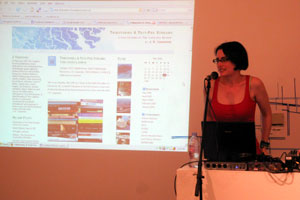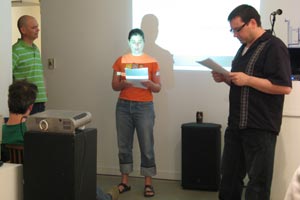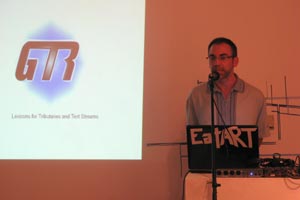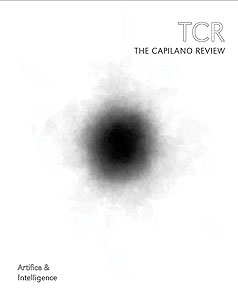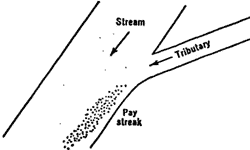May 22: My mother-in-law drove me to the airport during rush hour. To avoid the Metropolitan Autoroute she took a crazy back-roads route through neighbourhoods I didn’t even know we had in this city, including a Little India and a warren of apartment buildings that may or may not have been Ville Saint-Laurent. I gasped and clutched the dashboard a number of times, but a civilized conversation was maintained throughout, in French, and no injuries were sustained.
On the plane I sat next to a short fat neurotic woman who reminded me a little too much of certain people I’m related to. Throughout the five and a half hour flight she fiddled endlessly with an enormous handbag, forever foraging in it for candies with crinkly wrappers and discovering other half-eaten stashes of food. When I asked her to let me out to go to the washroom she left this purse and various other packages on the floor in front of her seat. Stepping over them I stumbled and fell into the armrest and by the time I got to the washroom I had a vicious arm-reset shaped bruise on my thigh.
In the washroom, massaging my new bruise, I was confronted with evidence of just how old the airplane was that we were all hurtling across the continent in. There was a metal foldout ashtray built in just below the sink – like the kind that used to come standard in the backseats of Buicks and Caddies and other gigantic valour-upholstered cars of the 1980s. Above the sink there was small horizontal hole in the wall. A diagram of a double-sided razor blade clearly indicated that this was an ideal place for disposing of double-sided razor blades. When this plane was built razor blades and cigarette lighters were allowed through airport security and smoking on board was permitted in rows 39 through 23. Those were simpler times my friends, simpler times.
Our flight arrived in Vancouver early. When does that ever happen? Tributaries & Text-Fed Streams curator Kate Armstrong picked me up at the airport and drove me to my friend Emilie’s where I’d be spending the next two nights. Emilie had sent driving instructions but I had forgot to print them. That’s all right, Kate said, I know where we’re going – I just don’t know the address. That was the only thing I did know: 919 number 9, I said. I may be no good with names or faces or dates or following directions, but I do have a head for numbers.

Emilie and I were roommates during a residency at the Banff Centre in 2006. When we first got there we had The Loudest Room. We joined forces and eventually got moved to a way quieter room, one with a balcony and a mountain view. She stayed at my place in Montreal late summer 2007 and directly thereafter many amazing projects came my way, including Tributaries & Text-Fed Streams, so as far as I’m concerned Emilie is good luck. Her apartment is massive by Vancouver standards. She has a balcony and a mountain view, but her bedroom is even louder than The Loudest Room. Luckily I always travel with earplugs and had an extra pair for her. So much to catch up on yet, one glass of wine and we went right to sleep.
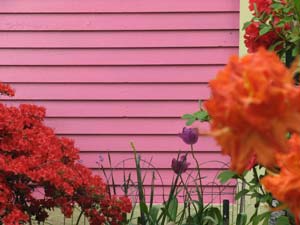
May 23: Jetlag was my friend in the morning when I still had lots of work to do in advance of the impending Tributaries & Text-Fed Streams launch, but jetlag was not my friend later that evening. I went for a walk to clear my head and was amazed to discover that Vancouver has colours we just don’t have in Montreal, and some crazy-looking trees I’ve never seen before. Back at Emilie’s we set about preparing to have a few people over for a Welcome to Vancouver / Reunion with Long-Lost Friends party. It turns out Emilie and I have dozens of long-lost friends in common and they’re all long lost friends of each other. Except for this one random girl, a friend of our friend Sameena who met her on the bus on way over, invited her in and she said sure. That’s when you know it’s a real party: when there’s someone there who doesn’t know anyone else.
As the evening unfolded we traveled back in time. Our stories crisscrossed and doubled back again in our retelling of them. We enacted a performance of remembering, drew maps of the interconnections between us that even we couldn’t follow, amazed ourselves with tales of what we’d been up to since we’d last seen each other and marvelled to find ourselves together again all in one room. Thrilled as I was to see everyone, I was falling asleep by 11PM. Everybody has to leave now, I whispered in Emilie’s ear at midnight. As soon as they were gone I missed them. Even the random girl.
May 24: By the time I woke up Emilie had already washed the kitchen floor – a gargantuan task. How could a dozen Long-Lost Friends make such a mess? I started in on the dishes. All was going fine despite the fact that doing dishes isn’t my sport and neither of us had had any coffee and there was none in the house. We were just discussing how and when to procure coffee when under the sudsy water the stem of a wine glass snapped in half and sliced the inside of my left thumb open. The wound was deep. It bled profusely. In seconds there was blood all over the recently washed kitchen floor and some blood on Emilie’s foot too. The blood didn’t freak her out so much as the steely resolve with which I insisted on rinsing the wound in cold water.
I was in shock. And I was furious. I had been working on Tributaries for six months and The Capilano Review had invited me out to Vancouver to launch it and now what if I couldn’t deliver? I was far from home. I hadn’t had any coffee. I am unused to having no idea what to do. Emilie bandaged me up and insisted I eat some eggs. I ate with my thumb above my head, and tried to sort out how I would know if I would need stitches or not. I couldn’t remember if I’d ever needed stitches before. The thought of spending the whole day in an emergency room enraged me. As did the difficulty of eating eggs over-easy whilst holding one bloody throbbing thumb in the air. At least it was my left thumb.
The phone rang. It was clearly someone Emilie didn’t want to talk to. I can’t talk right now, J.R.’s bleeding, she said, but the caller kept on talking. Finally my wound made itself useful. Blood began seeping out over my band-aid and dribbling down the back of my hand. Dude, I managed to intone, holding my thumb out in my friend’s direction. There’s really a lot of blood, she told the caller and hung up.
As soon as we were done eating Emilie got online and started searching for walk-in clinics. We took a taxi to the first one we found open on a Saturday AM that said they’d do stitches. The next part of the story is quite grizzly, but here are the good parts: We didn’t have to wait. Emilie was allowed into the exam room with me and was willing and able to squeeze the hell out of my other hand during the procedure. The doctor was our age and he had a sense of humour. Stitches were indeed needed, five of them! And a Tetanus shot. This goes into the “good parts” category because at least we weren’t over-reacting. While he was stitching me up the doctor asked me lots of questions to distract me. When he discovered that I was in town to launch a new project that evening and tried to get me to explain what it was about. Emilie admitted she had no idea what Tributaries was about either. I proceeded to fail miserably to explain the poetics of RSS. This goes into the good parts category because at least it got us all laughing. I got a big bandage and free drug samples. The best part was when it was all over we went outside and discovered a French café directly across the street from the clinic. There was a table in the sun on the terrace. We literally ran across the street toward that table in the sun.

Somehow we still had time to take the bus back to Emilie’s place, bathe (awkwardly) pack (sloppily) and haul my stuff downtown to the hotel I’d be staying in for the rest of my stay in Vancouver thanks to The Capilano Review. We made it to the gallery more or less on time for one of the worst technical set-ups I’ve ever been through. The internet connection conked out every time the cordless phone received a signal. The data projector would talk to some laptops and not others and for about an hour there it insisted on projecting upside down. I still in shock from the thumb wound. My brain was not functioning properly. At some point I gave up and went out to find Emilie and our friend Billy who’s artwork was just about the only thing functioning in the gallery at that moment. They were conveniently located in a near by park. I sank down onto the grass in despair. Billy consoled me with a neck rub. The weather was glorious and the view was stunning, all of which helped a lot.
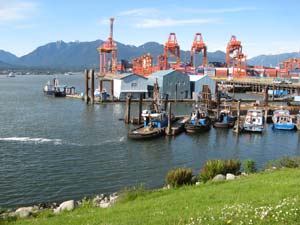
It was hot in the gallery. I was flushed and overwrought. I had a change of clothes with me, but decided to save them for some other day as my BO would only sully them and even two days into this trip I was all about making my fresh laundry last as long as possible. I didn’t dare have a drink, what with the shock and exhaustion and jetlag and pain medication, but fortunately for us all the DJ was one of the most positive, helpful and energetic human beings I’ve ever met and between him and the Long-Lost Friends, who turned out in droves, soon my energy was restored to near functional levels.
All things considered, the event itself went remarkably well. A good crowd came out. The internet connection didn’t conk out once during my performance. After my bit was done, a number of other folks performed riffs on the theme of Tributaries & Text-Fed Streams including my perpetually long-lost but always eventually found again friend Michael Boyce. With profound relief I witnessed the project moving beyond me, out into discourse as it were. Many people came up to me after and admitted that they hadn’t understood the project at all before hand but now they did, which was a load off my mind. The curator and commissioning body all seemed happy and eventually it was over and I had chic boutique a hotel room waiting for me, hurrah!
In an attempt to pull the hotel room window closed for the night I managed to both bang and cut my right elbow, which hurt like hell, but everything is relative after having already had stitches earlier in the day. I took a massive doctor-endorsed pain killer and slept and slept and slept.

May 25: The great thing about sustaining a bloody injury and yet somehow getting through the day is that for days afterward everything else seems lovely in comparison. “The day after” was bliss. Two dear long-lost friends made me breakfast in the morning and organized a beach BBQ in the evening to which many more long-lost friends flocked and there was food and beer and a Frisbee and a dog and a glorious sun set and really the only difficulty we had was that we were too lazy to walk all the way to the restrooms so we waited till we were driving out and by then we thought we might die of needing to pee but of course we didn’t die at all. After availing ourselves of the facilities we amused ourselves by taking pictures the lights of distant Vancouver. Surely it’s a sign of true friendship when we enjoy each other’s company so much that it doesn’t seem strange at all to spend a half an hour taking pictures together in the dark.
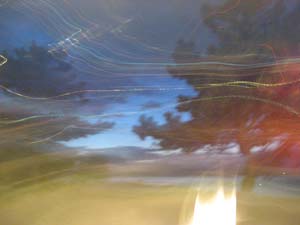
May 26: No injuries were incurred on this day. Only some slight confusions. Long-lost Michael and I went for breakfast. He forgot his phone and had to go back for it. Then we went for a long walk. He pointed out that many buildings in Vancouver have nautical elements in their architecture. Down by the waterfront I said: Wow, this building looks like a cruse ship. It actually was a cruse ship! How embarrassing!! And yet what a relief. I mean it would have been pretty strange if every single one of the condo owners in the building had the exact same deck chairs.
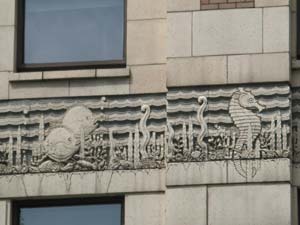
Later I went to meet Emilie at the gallery she works. She was going to let me in to see the show for free but I couldn’t find her anywhere. I thought I’d missed her, but then through the magic of text messaging another long-lost friend who works at the same gallery came and found me in the lobby and just then Emilie found us and soon all was well. The exhibition was awesome, but by this time I was dead tired. Luckily there was a movie playing in a darkened room equipped with comfy couches. Let’s face it, there’s hardly ever a comfy couch in the middle of the day in a public place at just the moment when you need a nap.
Later still I went to dinner with a long-lost friend who had been at the Welcome to Vancouver party, the Tributaries Launch and the Beach BBQ. Previous to the Welcome to Vancouver Party we hadn’t seen each other for fifteen years; we still had a lot of catching up to do. We decided to eat at a Thai place with a terrace. We knew it was the right place because my orange and fuchsia top matched the décor. The heat lamp over the terrace was so hot we thought we’d have to move inside but then we came up with a brilliant idea: We asked the waiter to turn off the heat lamp and he did. Every one else on the terrace cheered. Why didn’t any of them think to ask the waiter to turn the heat lamp off, we wondered?
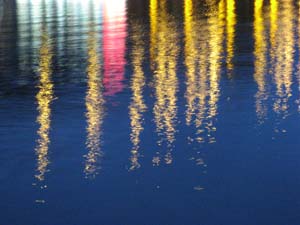
After dinner long-long-lost friend and I went for a long long walk along a beach and took pictures in the dark… I guess this happens fairly often in Vancouver. We walked and walked and talked and talked and wound at pub, which is exactly what we used to do when we knew each other the first time around. The big difference being: the first time around I was twenty and too lonely to notice that I was surrounded by friends. And now, boy, do I know better. No I know that long-lost friends almost always remember things differently than you do. They remember the good things; they have the power to give back pieces of the past to you untarnished and intact.
The present is a gift, as Michael Boyce says.
June 3: Back in Montreal. I took my stitches out myself. The wound appears healed yet it still hurts. The scar is hardcore. The long-lost friends are all lost again but hopefully not for too long. In the meantime, I miss you all a lot.
. . . . .









